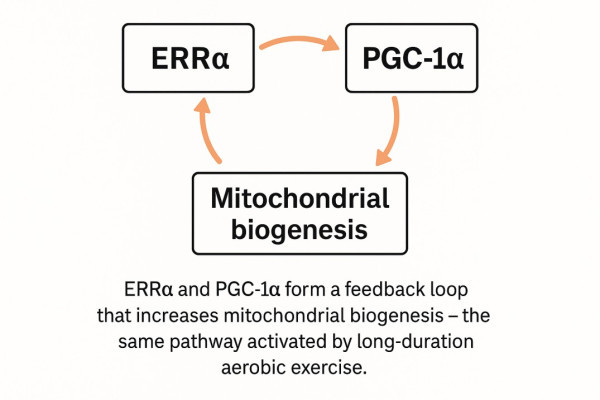The “Exercise Pill” That Tricks Your Muscles

What Is SLU-PP-332 and Can It Really Mimic Exercise?
SLU-PP-332 is an early-stage compound that activates the same endurance pathways as aerobic exercise — without physical movement. It boosts fat oxidation, mitochondrial biogenesis, and muscle energy metabolism in animals. But no human trials exist, safety is unknown, and it’s years away from clinical use.
SLU-PP-332 is an experimental exercise mimetic that activates endurance pathways by targeting ERR receptors responsible for fat oxidation and mitochondrial biogenesis. Animal studies show improved metabolic function without physical movement, but no human safety or efficacy data exist yet, and the compound remains in early preclinical development.
What Is SLU-PP-332 and How Does an Exercise Mimetic Work?
Every few years, science teases a molecule that sounds like science fiction. SLU-PP-332 is the latest candidate — an “exercise mimetic,” meaning a compound designed to mimic the biological effects of endurance training.
Developed by researchers at Washington University, SLU-PP-332 works by activating estrogen-related receptors (ERRα, ERRβ, ERRγ).
These are not hormonal receptors. Instead, they are metabolic switches that tell skeletal muscle:
> Burn more fat
> Increase mitochondrial output
> Boost endurance gene expression
> Shift into “energy mode” rather than “storage mode”
Animal studies show that sedentary mice given SLU-PP-332 activate the same gene pathways seen in endurance athletes — without running, cycling, or lifting.
“SLU-PP-332 activates the same endurance pathways triggered during aerobic exercise, including ERR receptors and PGC-1α — the master regulator of mitochondrial biogenesis.”
This is why the scientific community is paying attention. ERRs are upstream regulators of the metabolism of longevity.
How Does SLU-PP-332 Affect Metabolism and Longevity?
From a longevity perspective, cardiometabolic health is one of the strongest predictors of lifespan and healthspan. Exercise improves:
> Mitochondrial density
> Glucose disposal
> VO₂ max
> Insulin sensitivity
> Neurotrophic growth (BDNF)
SLU-PP-332 is not a stimulant or fat burner. It bypasses calorie restriction, thermogenesis, and sympathetic activation. Instead, it reprograms muscle metabolism at a cellular level.
In animal studies, SLU-PP-332 enhances:
> Fat oxidation
> VO₂ max equivalents
> Endurance gene activation
This is the exact metabolic fingerprint of endurance exercise — just without movement.
For individuals who are aging, mobility-limited, or metabolically compromised, an exercise mimetic could help maintain muscle health and metabolic function.
But that’s the theory.
Reality is more complicated.
Is SLU-PP-332 Safe? Known Risks and Unknowns
Right now, we don’t know if SLU-PP-332 is safe — at all.
> No human trials.
> No toxicity data.
> No long-term results.
> No dosage understanding.
SLU-PP-332 is in preclinical research, which means many promising molecules fail at this stage.
History is full of abandoned exercise mimetics:
> AICAR — improved endurance but wrecked metabolism at high doses
> GW501516 (Cardarine) — extraordinary fat-burning effects but caused cancer in animal studies
SLU-PP-332 uses a different pathway (ERR instead of AMPK/PPARδ), which is promising — but still untested.
“No human trials of SLU-PP-332 exist yet, making safety, dosing, and long-term effects entirely unknown.”
For now, the science is exploratory — not prescriptive.
How Does SLU-PP-332 Work in the Body and Why Isn’t It Ready for Humans?
SLU-PP-332 acts as an ERR agonist, meaning it “turns on” receptors involved in:
> Fat burning
> Muscle energy metabolism
> Mitochondrial output
> Endurance gene expression
This produces effects similar to fasting, aerobic training, or prolonged physical activity:
> Higher mitochondrial density
> Improved VO₂ max markers
> Lower fat mass (with no diet changes)
But here’s why it’s not ready:
1. No human toxicology studies
Regulators require multi-stage safety testing before human use.
2. Off-target metabolic effects are unknown
ERR activation affects multiple tissues — not just muscle.
3. Potential regulatory and anti-doping implications
WADA has already banned several exercise mimetics.
4. Longevity interventions demand long-term data
A molecule that alters mitochondrial signaling can’t be rushed.
SLU-PP-332 is a conceptual breakthrough, not a consumer product.
How Does SLU-PP-332 Compare to Other Exercise Pills?
AICAR
> AMPK activator
> Boosted endurance in animals
> Failed due to metabolic complications
GW501516 (Cardarine)
> PPARδ agonist
> Rapid endurance improvements
> Caused cancer in rodents → abandoned
SLU-PP-332
> ERR agonist
> Strong mitochondrial and fat-oxidation effects
> No human data → safety unknown
Who Could Benefit Most From Exercise Mimetics?
If exercise pills become safe and approved (a big “if”), they could help:
> Older adults with mobility limitations
> Patients recovering from injury or surgery
> Individuals with chronic disease affecting movement
> Astronauts in microgravity
> People fighting metabolic dysfunction
They are not for replacing exercise in healthy adults — they’re for bridging gaps.
When Will SLU-PP-332 Be Available for Human Trials or Use?
Realistically:
> Preclinical stage → where it is now
> 2–5 years → early Phase 1 human trials (if funded and successful)
> 5–10 years → potential therapeutic pathway
> Never → if major safety problems arise (common)
Drug development is slow — especially for metabolism-modifying compounds.
What’s Next for SLU-PP-332 and the Future of Exercise Mimetics?
As our understanding of energy sensors like AMPK, ERRs, and PPARs deepens, the concept of mimicking exercise may become a pillar of longevity medicine.
But the future of SLU-PP-332 depends on:
> Funding
> Toxicology data
> Human safety results
> Regulatory environment
> Off-target effects
If successful, exercise mimetics could transform:
> Sarcopenia treatment
> Metabolic disease care
> Rehabilitation
For now? Exercise is still free.
In Closing (from Brent)
The idea of an exercise pill is seductive — more energy, more performance, more endurance with less friction. SLU-PP-332 may one day help those who can’t move like they used to. But no molecule can replicate the neurological, hormonal, mechanical, and emotional benefits of real movement.
If you want to activate your ERR receptors today, the answer is simple:
Move. Sweat. Breathe.
Your mitochondria know the difference.
If you run a longevity or metabolic health clinic offering GLP-1 programs and want to streamline client onboarding, improve retention, or scale demand, explore the Clinic OS operating system used by top clinics at Longevity Clinic Marketing.
FAQs About SLU-PP-332
What is SLU-PP-332?
SLU-PP-332 is an experimental exercise mimetic that activates endurance-related metabolic pathways by targeting ERR receptors. It has shown promising effects in animals but has not been tested in humans.
Is SLU-PP-332 safe?
Unknown. No human trials have been conducted, and long-term risks are unknown.
Could SLU-PP-332 replace real exercise?
No. It may mimic certain endurance benefits but cannot replicate the neurological, hormonal, biomechanical, or psychological benefits of actual movement.
When will SLU-PP-332 be available?
It is years away and may never reach the market depending on safety and regulatory outcomes.
How does it compare to other exercise mimetics?
It targets ERR receptors instead of AMPK or PPARδ, which may reduce certain risks — but human data is needed.
Disclaimers
Medical disclaimer:
Content is for educational purposes only and is not medical advice. Always consult a qualified healthcare professional before making changes to your health regimen.
Affiliate disclosure:
Spannr may receive compensation when you click partner links and make a purchase. As an Amazon Associate, we earn from qualifying purchases.
HIPAA/PHI notice:
Do not send personal medical information to this inbox. Spannr does not collect or store PHI via email.
About the Author
Sign Up For Our Newsletter
Weekly insights into the future of longevity


